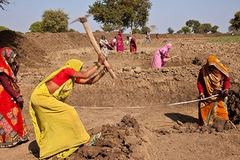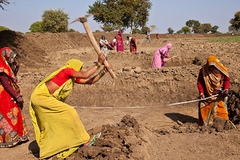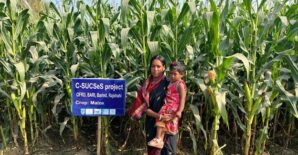Introduced in 2006, India’s Mahatma Gandhi National Rural Employment Guarantee Scheme (MGNREGS), one of the most ambitious programs of ruling government with the aim to reduce poverty by granting rural household right to employment up to 100 days per year at minimum wage rate. Self-targeting design with the aim to capture pro-poor section the program plans to increase employment and incomes of rural poor. IFPRI discussion paper on Heterogeneous pro-poor targeting in India’s Mahatma Gandhi National Rural Employment Guarantee Scheme explores the degree to which MNREGAS targets pro-poor both at national and state level.
Following the three parameters such as participation, rationing and job-seeking, the authors studies the dynamics of the program, from the 66th round of National Sample Survey covering 58, 263 rural household in 27 states. It is observed that there has been overall 24 per cent participation in the program with huge variation across states, ranging from 4-5 per cent in Haryana, Maharashtra, and Punjab to 89 per cent in Mizoram. Looking at the scale of its operation, the variation can be observed due to --
1. Self -selection leads to greater participation by poorer and disadvantaged households
2. Administrative rationing in MNREGS is not pro-poor, many of the state report card unveils middle class bias i.e. household near poverty line likely to receive job than poorer households
3. Though MNREGS offers equal wage for men and women, data shows limited reach towards female headed households, due to self-selection and rationing effects
4. Self -selection in some states with rationing towards selection of schedule caste and tribes (SC/ST)
The desired targeting pattern is high and pro-poor (i.e., progressive) participation with little rationing among the poor. Deviations from this desirable standard can occur in any of three directions: i) participation rates are low for the poor, ii) the participation and rationing profiles are flat or regressive (i.e. upward-sloping), or iii) rationing is high among the poor. Inter-state variation can be observed in many states, Arunachal Pradesh and Jammu and Kashmir deviate from pro-poor targeting in all the three directions. In Jammu and Kashmir the participation rate was below 20 per cent, while rationing reached 60 per cent for the poorest households. On positive side out of the 27 states, 13 states fared well in pro-poor targeting. Success stories can be employed to improve livelihood of poor household and lessons learnt from Manipur, Mizoram, Rajasthan, Sikkim and Tripura can be taken by both national and state governments for the successful reach of the program to the targeted section of the population.




